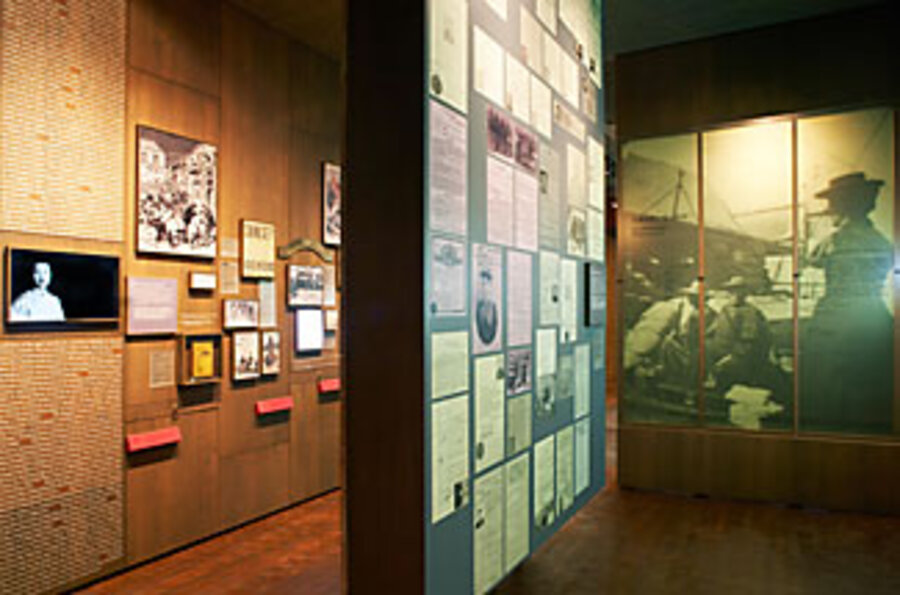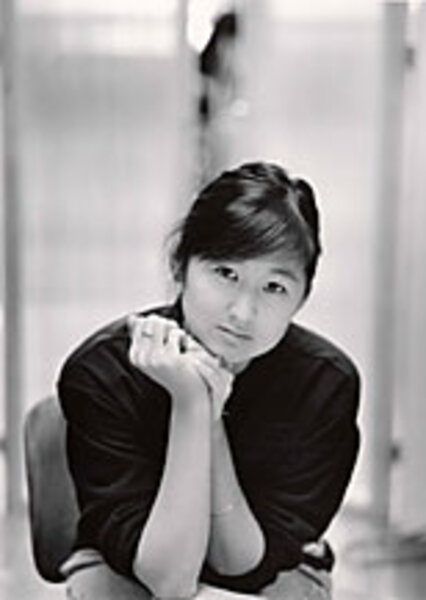Museum of Chinese in America opens in New York
Loading...
| New York
New York boasts a brand-new museum, the Museum of Chinese in America (MOCA), which is noticeably different from others. Many of the artifacts were salvaged from the detritus of Chinatown: straw sandals from Mott Street, an eight-foot sign advertising a Chinese laundry, and shelves from a general store being dismantled on the Bowery. Forget bidding at auction for precious items like jade and lacquer. Dumpster diving was one tactic to assemble the collection. "We don't have spectacular pieces that fetch a lot of money at Christie's," says S. Alice Mong, MOCA's director, "but letters and things that are memories, stories, and histories."
MOCA began 30 years ago as a grassroots organization founded by Charles Lai, a community activist who grew up in Chinatown, and historian John Kuo Wei Tchen. "When Charlie and I started," Mr. Tchen says, "there was no place to find true stories of the Chinese in New York, although there were plenty of places to find stereotypes."
The Tony Award-winning playwright David Henry Hwang agrees. When researching Chinese history for his plays like the 1988 hit "M. Butterfly," the lack of documentation, he says, showed "a vacuum of information about this important group and important piece of the American story."
The facts to fill in the blanks resided in old-timers' memories. The two founders conducted oral history interviews with elderly residents of Chinatown. Now the relics and stories are housed in a handsome space designed by famed architect Maya Lin. In an opening ceremony Sept. 22 featuring a traditional lion dance, Mayor Michael Bloomberg "dotted the eye" of the lion with a red mark, symbolically awakening it and bringing the new facility to life.
What brings the collection to life are the stories collected by Mr. Lai and Tchen. It's a narrative of hardship and struggle that includes 200 years of history of Chinese in the United States. It is not, for the most part, a pretty story.
Chinese began arriving in large numbers in California during the gold rush of the 1850s, then played a major role in building the transcontinental railroad in the 1860s. Yet by 1870, these "rice-eaters" were vilified. A New York newspaper claimed Chinese workers "will work for half price, and live upon a mouse or a rat, and call it a dainty morsel." Labor leader Denis Kearney appealed to xenophobia when he labeled Chinese "almond-eyed lepers."
The Naturalization Act of 1870 specifically excluded Chinese residents from becoming US citizens, and in 1882 the Chinese Exclusion Act forbade Chinese laborers from immigrating to America, the first federal law to restrict immigration based on nationality. Prior to this, an open-door policy had welcomed a flood of immigrants, with only "prostitutes, lepers, and morons" excluded, a roster of undesirables to which the Chinese were added.
Not until 1943 (when the Chinese were our allies in World War II) was the Exclusion Act repealed, replaced by a quota of 105 Chinese workers admitted per year. It took the Civil Rights Act of 1964 to eliminate discrimination based on race.
How to tell this story? Curators of the core exhibition, "With a Single Step: Stories in the Making of America," opted for a high-impact approach.
"We made a conscious decision not to assume a dry, authoritarian voice but to make the experience affective," says Tchen. To underscore commonalities with the Chinese experience, they designed evocative spaces to elicit emotional reactions.
One room displays cringe-inducing Hollywood movie posters of clichéd characters like Charlie Chan, with a Fu Manchu mustache. Popular "yellow-face" performers and outlandish Hollywood type-casting created an inscrutable, sneaky caricature, "the exotic, erotic 'other,' " says Tchen. The stereotype would be ludicrous if it were not so damaging, leading to what he calls "a moment of incredible obstacles and near social death." Chinese men were forced into "women's work" – slaving in laundries, chop-suey restaurants, and domestic service – for survival.
The design of the museum also packs a gut punch. Transforming an old machine repair shop, Ms. Lin deliberately left exposed a light shaft in the center, its brick walls redolent of tough times. Lin "sees our history as raw," Ms. Mong explains. "We shouldn't cover it up with beautiful walls.... What Maya celebrates is our origin. It's not perfect, but it has character."
MOCA's ambition is "to be the source of our information based on historical documentation and facts – the good, the bad, the ugly, the prejudice, and the triumph," according to Mong.
Lai hopes the collective memories presented will touch viewers and overcome Americans' historical amnesia. He cites the consistent tendency for each succeeding immigrant wave – from Irish, Italian, German, Jewish, to Latino – to be "considered the scum of the earth, the ones bastardizing the growth of America." Because their language, cuisine, and customs are different, each group is demonized as a threat to American jobs and culture, he says, before assimilating and adding their contribution to America's dynamic growth.
Tchen aims to educate the public about Chinese Americans' epic journey: from oppression and isolation to fighting for their rights through the court system and eventual recognition as "the model minority." Despite this happy outcome in a complicated tale, he says, "I don't think the battles are over." He feels an urgency to overcome lurking stereotypes through stories that underscore our common humanity. "That's our best chance to fight stereotypes."
Past cross-cultural misunderstanding produced, he says, the idea of China as an enemy, a fear in the back of Americans' minds now that China is a global power. Fear breeds suspicion and questioning of Chinese Americans' allegiance, as during the McCarthy era when many were accused of being spies.
The museum presents the negatives and positives of a difficult struggle for acceptance and inclusion. "Look at the journey that took us there," Mong says. "Don't take it for granted but consider the shoulders we stand on, the heartbreaks others endured. We hope to remind people the journey continues."






